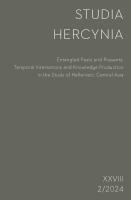Greeks, Iranians, and Kušān in Tokharistān. Bactrian Identities and the Kušān Empire
Greeks, Iranians, and Kušān in Tokharistān. Bactrian Identities and the Kušān Empire
Author(s): Stefan HärtelSubject(s): Archaeology, Ancient World
Published by: Univerzita Karlova v Praze - Filozofická fakulta, Vydavatelství
Keywords: Kushan; Bactria; élites; language; administration; identity
Summary/Abstract: The Bactrian epigraphic and numismatic material from the Kušān period, despite its scarce, eclectic and scattered nature, contains a wealth of information about cultural and ethnic identities in Bactria at the time. The Kušān interacted with Iranian and Greek legacies while adding their own heritage to the mix. Kušān inscriptions and seals document the presence of individuals with names from all three spheres in the Kušān imperial hierarchy, while the numismatic pantheon is assembled from deities from these various religious backgrounds. There are several indicators showing that the Kušān possessed active awareness of this cultural heterogeneity and used it to shape a definition of Bactria for their own purposes. This paper examines this evidence and concludes that the Kušān saw the Iranian and Greek elements as equally indigenous to Bactria and that they did not employ a deliberately anti -Greek policy.
Journal: Studia Hercynia
- Issue Year: 28/2024
- Issue No: 2
- Page Range: 108-121
- Page Count: 14
- Language: English

